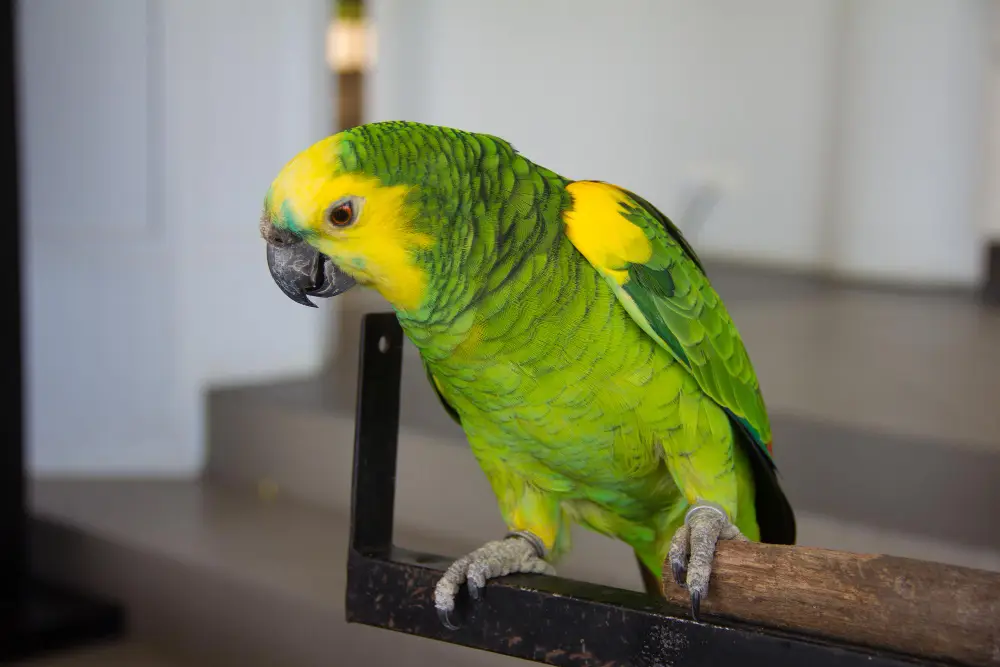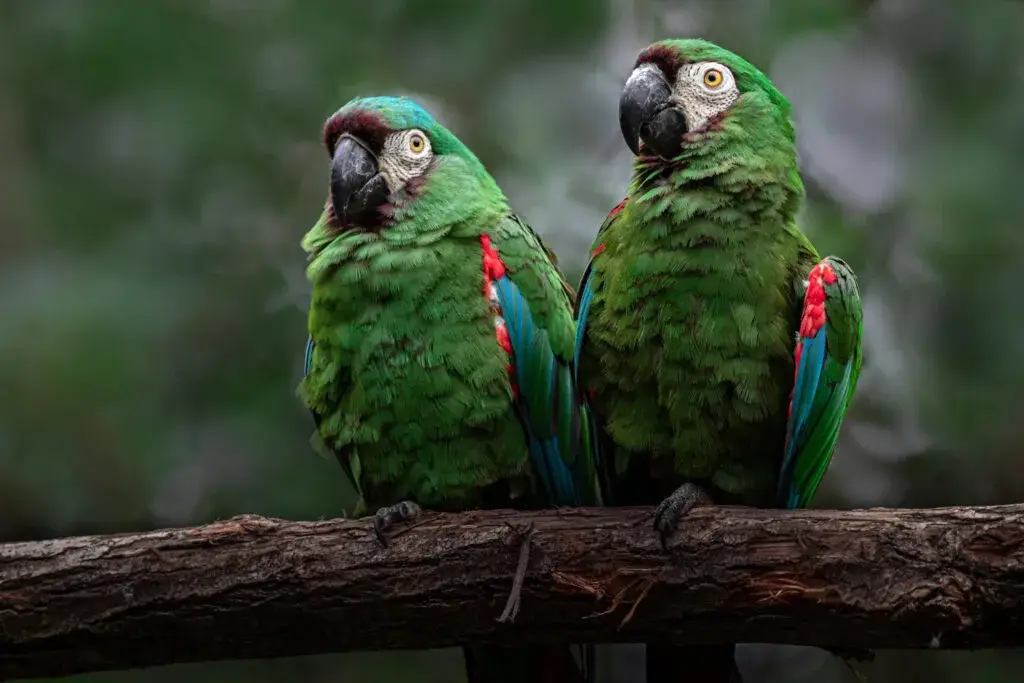Amazon parrots (Amazona) are among the most recognisable parrots, native to the Neotropics from Mexico through South America and the Caribbean. Predominantly green with vivid accents of yellow, red or blue, they span about 25–48 cm (10–19 in) depending on species from the petite White-fronted Amazon to the imposing Imperial Amazon.
Highly intelligent and social, they can live 40–50+ years (and occasionally far longer) when given space, daily interaction and a balanced, pellet-based diet with fresh vegetables and fruit making them genuine lifelong companions rather than short-term pets.
| Amazon Parrot Species | Average Size (Length) | Average Weight |
| Yellow-headed Amazon | 15–17 in (38–43 cm) | 400–600 g |
| Yellow-naped Amazon | 15–17 in (38–43 cm) | 480–680 g |
| Double Yellow-headed Amazon | 15–17 in (38–43 cm) | 450–650 g |
| Blue-fronted Amazon | 14–15 in (35–38 cm) | 400–550 g |
| Lilac-crowned Amazon | 12–14 in (30–35 cm) | 310–480 g |
| Orange-winged Amazon | 12–13 in (30–33 cm) | 340–480 g |
| Red-lored Amazon | 12–14 in (30–35 cm) | 400–600 g |
| Mealy Amazon | 15–17 in (38–43 cm) | 540–700 g |
| White-fronted Amazon | 9–10 in (23–25 cm) | 200–300 g |
| Spectacled Amazon | 10–12 in (25–30 cm) | 250–400 g |
Amazon Parrot Care Guide for Beginners
Amazon parrots are colourful, intelligent, and social birds, but they need the right care to thrive. As a beginner, focus on three basics: housing, diet, and daily interaction. A spacious cage, fresh water, and a balanced diet are essential.
Spend time with your parrot every day. These birds are highly social and can become stressed or aggressive if ignored. Introduce toys and foraging activities to keep their minds active. Regular vet check-ups are also a must for long-term health.
How to Train an Amazon Parrot to Talk
Amazon parrots are excellent mimics. Start training in a quiet room with no distractions. Use short, clear words and repeat them daily. Words tied to actions, such as “hello” when you enter the room, work best.
Reward your parrot with treats and praise when it tries to speak. Keep sessions short—five to ten minutes—so the bird stays engaged. Consistency and patience are key. With time, many Amazons build impressive vocabularies.
Best Food for Amazon Parrots at Home
A balanced diet keeps Amazon parrots healthy. Offer a mix of high-quality pellets, fresh fruits, and vegetables. Leafy greens, carrots, apples, and berries are all great choices.
Avoid feeding too many seeds and nuts they’re high in fat and can lead to obesity. Fresh water should always be available. Treats like almonds or sunflower seeds can be given in moderation as training rewards.
Different Species of Amazon Parrots Explained
There are more than 30 species of Amazon parrots, each with its own look and personality. Popular types include the Blue-fronted Amazon, known for its talking ability, and the Yellow-headed Amazon, famous for its bright plumage and bold nature.
Smaller species like the White-fronted Amazon are lively and playful, while larger ones such as the Mealy Amazon are calmer but need extra space. Understanding the differences helps new owners choose the right companion.
Yellow-naped Amazon
Famous for their talking ability, they can build large vocabularies and mimic tones with emotion. Unfortunately, they are now endangered in the wild.

Yellow-headed Amazon
Known for their strong, clear voice, these parrots are natural singers and talkers. They often bond deeply with one person and can be protective of them.
Blue-fronted Amazon
Easily recognised by their blue forehead and yellow cheeks, they are playful, lively, and love singing. They need toys and challenges to stay stimulated.
Orange-winged Amazon
Though a little quieter than some species, they still mimic well. They are sociable and fun, but may push boundaries as they mature.
Red-crowned Amazon
Affectionate and cheerful, they enjoy interaction and often learn to copy household sounds. In captivity, they may live for more than 50 years.
Lifespan of Amazon Parrots in Captivity
Amazon parrots are long-lived birds. With good care, many live 40 to 50 years, and some reach 60 or more. Their long lifespan means owning one is a lifelong commitment.
A balanced diet, regular exercise, and annual vet visits all contribute to longevity. Mental stimulation—like training and toys—also prevents stress-related health issues, helping them live longer, happier lives.
Tips for Keeping Amazon Parrots Healthy
Keep your parrot’s cage clean by changing the lining and washing food bowls daily. Provide fresh water and rotate toys often to prevent boredom.
Encourage exercise with out-of-cage time in a safe space. Schedule yearly check-ups with an avian vet, and watch for signs of illness such as feather plucking or changes in appetite. A mix of good hygiene, nutrition, and attention keeps Amazons healthy.
Are Amazon Parrots Good Family Pets?
Amazon parrots can make wonderful family pets, but they are not for everyone. They are intelligent, social, and often affectionate, making them great companions.
However, they need lots of time and interaction. Without it, they may become noisy or aggressive. Families with older children or adults who can share responsibility often do best. If your household is busy and engaged, an Amazon parrot can thrive.
Common Behaviour of Amazon Parrots
Amazon parrots are playful, curious, and love attention. They enjoy learning tricks and can be loud, especially in the morning and evening.
They may display territorial behaviour during breeding season, which is normal. Body language is important: raised feathers or dilated pupils often signal excitement or agitation. Recognising these behaviours helps owners build a stronger bond.
Housing and Cage Setup for Amazon Parrots
A spacious cage is essential for Amazon parrots. Choose one at least 36” wide and 48” high, with strong bars that can handle their beaks.
Add multiple perches of different textures to promote foot health. Provide chewable toys and foraging puzzles for mental stimulation. Place the cage in a busy part of the home where the bird can interact but avoid direct drafts or kitchen fumes.
How Intelligent Are Amazon Parrots Compared to Other Birds?
Amazon parrots are among the most intelligent bird species. They can learn words, songs, and even short phrases, rivaling African Greys in talking ability.
Their problem-solving skills are remarkable. They often figure out how to open cage latches or use objects as tools. This intelligence makes them engaging companions but also means they need constant stimulation to prevent boredom.
FAQs About Amazon Parrots
Q1: Which Amazon parrot is the best talker?
The Yellow-naped Amazon is often considered the most talented talker, thanks to its clear voice and quick learning ability.
Q2: How long do Amazon parrots live?
With proper care, most live between 40 and 60 years, though some may reach 80.
Q3: Are Amazon parrots noisy?
Yes, they can be very loud, especially in the mornings and evenings. Keeping them busy and well-trained helps manage noise.
Q4: What should I feed an Amazon parrot?
A balanced diet of pellets, fresh vegetables, and fruit is best. Seeds and nuts should only be given in moderation.
Q5: Do Amazon parrots bond with one person?
Many species do bond closely with a single carer, but good socialisation from a young age helps them feel at ease with the whole family.







